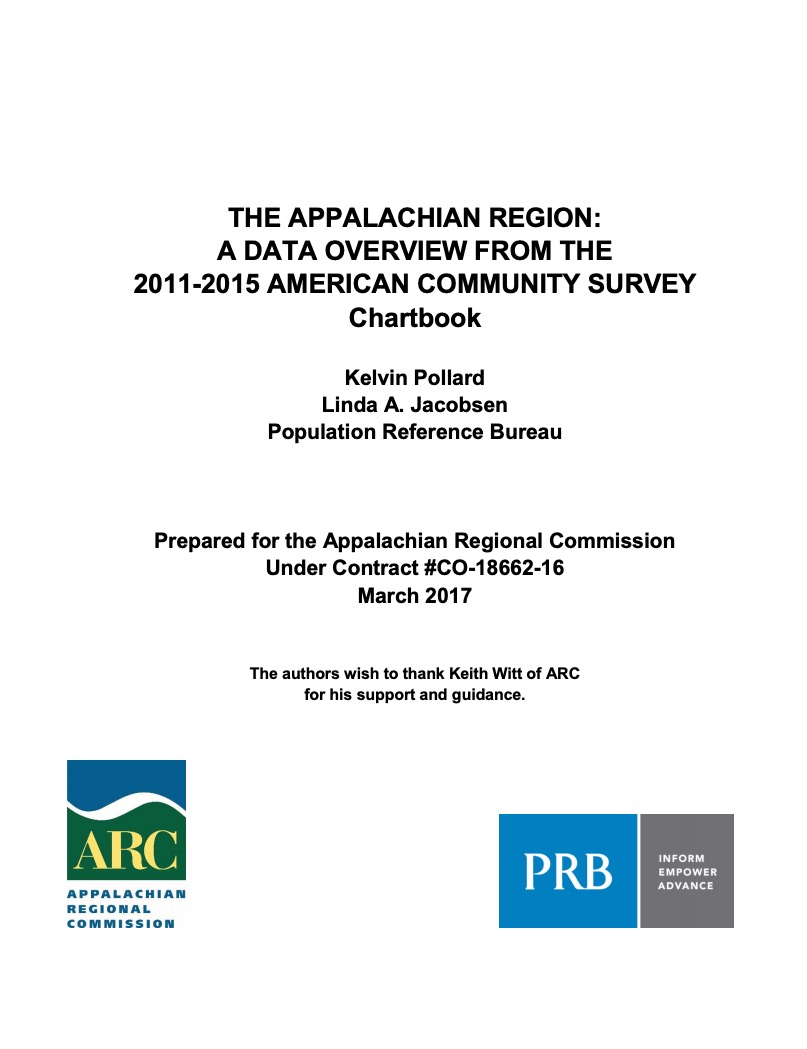
The Appalachian Region: A Data Overview From the 2011-2015 American Community Survey
Appalachia’s unemployment and poverty rates remain above levels seen before the economic downturn of 2007-2009, suggesting an incomplete economic recovery, especially in many of the Region’s most rural counties, according to a new Population Reference Bureau (PRB) report for the Appalachian Regional Commission.
The Appalachian Region: A Data Overview From the 2011-2015 American Community Survey—co-authored by Kelvin Pollard, PRB senior demographer, and Linda A. Jacobsen, PRB vice president of U.S. Programs—compares newly released American Community Survey data for 2011-2015 with 2006-2010 data to show trends in income, employment, and other indicators at the regional, subregional, state, and county levels. The Region encompasses 205,000 square miles along the Appalachian Mountains from southern New York to northern Mississippi, including portions of 12 states and all of West Virginia.
Although Appalachia’s 2011-2015 unemployment rate matched the national average of 6.9 percent, it was still slightly higher than in 2006-2010. In addition, unemployment varied widely across the Region. For example, unemployment was less than 5 percent in 39 counties, with 29 of them located in New York, Pennsylvania, Virginia, and West Virginia—the states whose Appalachian sections had the lowest jobless levels. Conversely, the jobless rate was at least 10 percent in 54 counties—42 of which were outside metropolitan areas and 48 of which were in Central, South Central, and Southern Appalachia.
The report’s authors point to signs of a connection between unemployment and educational attainment: In 52 of the 54 Appalachian counties with double-digit unemployment, the share of 25-to-64-year-olds with at least a high school diploma was below the national average of 88 percent; in 27 of these counties, the share was below 80 percent.
During the 2011-2015 period, just 23 percent of adults ages 25 and over in Appalachia had at least a bachelor’s degree, which was seven percentage points lower than in the nation as a whole. The share was lower than the national average in 399 of the Region’s 420 counties. In the Appalachian sections of six states (Kentucky, Maryland, Mississippi, Ohio, Virginia, and West Virginia), the share with a bachelor’s degree or more was at least 10 percentage points below the national average.
However, the authors note that the share of adults with a four-year degree was two percentage points higher in 2011-2015 than in 2006-2010, and the share with at least a high school diploma rose three percentage points during the period, suggesting a continued trend toward greater educational attainment in the Region.
Since 2006-2010, the share of Appalachian residents in poverty (incomes below $24,036 for a family of two adults and two children in 2015) has risen 1.5 percentage points to 17.1 percent in 2011-2015. Poverty increased throughout the Region—in all subregions and among both rural and urban counties. The rise in poverty rates was especially high (more than two percentage points) in the Appalachian portions of Georgia, Maryland, North Carolina, and South Carolina.
Every age group under age 65 experienced an increase in poverty: Child poverty in Appalachia rose almost three percentage points (to 24 percent), and poverty among working-age adults increased nearly two percentage points. Although the overall rise in the poverty rate among Appalachian young adults (ages 18 to 24) of 1.2 percentage points was less than the national average of 1.8 percentage points, it was significantly higher in some parts of Appalachia—more than three percentage points higher in the Appalachian sections of Maryland and Virginia; and more than four percentage points greater in Appalachian North Carolina.
Overall, Appalachia’s population grew less than 2 percent between the two periods, less than half the national average. Growth was even slower in large parts of the Region: The Appalachian sections of Kentucky, New York, Ohio, Pennsylvania, and Virginia have actually lost population since 2006-2010.
Appalachia’s residents are older, on average, and less racially and ethnically diverse than the U.S. population as a whole, but these and other demographic, health, and socioeconomic patterns vary widely within the Region, the report shows.
The full report includes detailed tables and county-level maps, covering state- and county-level data on population, age, race and ethnicity, housing occupancy and tenure, education, labor force, employment and unemployment, income and poverty, health insurance coverage, disability status, migration patterns, and veteran status.

 ">
">